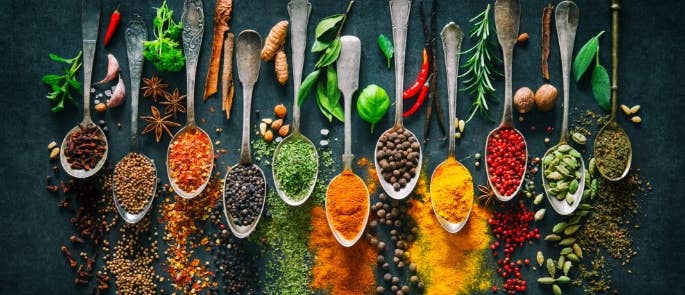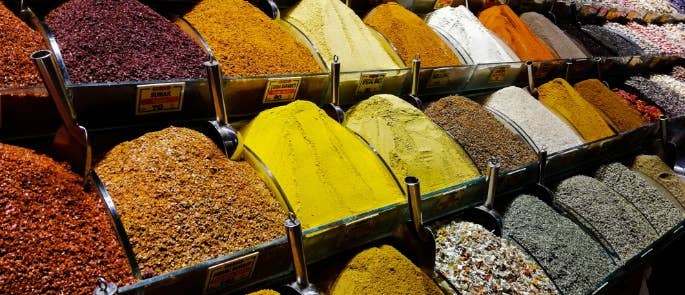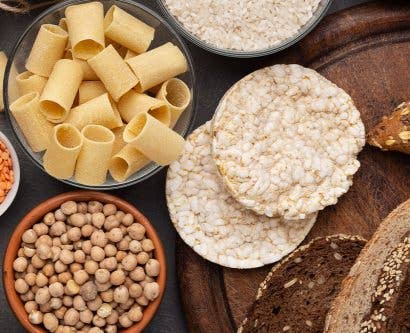What is Flavour?: Guidance on Food Pairings
Flavour is one of the most important factors in the creation of food products and meals. Understanding flavour combinations is a skill which any chef or avid cook alike will tell you is key to levelling up your cooking skills. While flavour is largely subjective, it is ultimately governed by the more universal tastes that we experience. Flavours can bring back memories and make you remember a meal you had when you were younger. As such, it’s important that you understand flavour combinations so you can make delicious and memorable foods that people might just remember for years to come.
In this article, we will explain what flavour is and why it is important to the food products you make, We’ll also issue guidance on understanding flavour profiles and provide you with a free downloadable food pairing chart to help you better understand and put into practice what you learn from this article.
Starting a Home Food Business?
If you’re looking to master your flavour combination skills and enhance your own food creations, why not consider our Starting a Home Food Business course, and learn how to successfully start your own food business from your home.
What is Flavour?
In a recent article – What is Taste and Why is it Important in Food Products? – we discussed the 5 different types of taste. The idea of taste is more objectively set in stone, whereas flavour is a concept which is seemingly limitless – 5 tastes, limitless flavours. Taste refers to the five basic tastes humans are able to perceive and it comes into play when understanding flavour whereas flavour is an attribute of a chemical substance, produced by the senses of smell, taste, and touch perceived within the mouth.
Flavour is a package that combines taste, smell, memory, personal experience and so much more. It fills the gaps where taste cannot. Through flavour alone, we can describe subjective experiences such as the taste of a summer’s first strawberry or a greasy burger after a night out.

What are the different types of flavour?
When looking at food and beverage regulations, flavours are typically broken down into three main categories:
- Natural flavours – This refers to processed ingredients derived from plants, essential oils, proteins, yeasts, etc. These ingredients can be classified as a GRAS (Generally Recognised As Safe) ingredient or as a food additive as defined by the FSA depending on the ingredient composition. Examples of natural flavours can include citruses such as lime, lemon and orange, vanilla, lavender and rose.
- Artificial flavours – These are chemically composed ingredients and they are usually regulated as a food additive – these require additional rigorous safety assessments before being available on the market to ensure they are safe for human consumption. To find out more on food additives, read our article here.
- While most artificial ingredients are considered additives, there are some artificial flavours are that are classified as GRAS ingredients, and include many different commonly found flavours such as strawberry, cinnamon, vanilla, and more.
- Spices – Spices are primarily aromatic vegetables or plants that can be found in many forms, such as dried and ground, broken, or whole – they include ingredients such as pepper, rosemary, basil etc. These ingredients are typically considered GRAS ingredients.

These three core categories of flavour essentially make up the food and beverages we consume. They make up a vast field of different flavour combinations and thus new flavours and profiles.
Looking to learn more?
It’s all well and good creating food that tastes good, but if this same food poses a threat to your customers’ health, word will spread and your business will suffer. To learn more consider taking a look at our Food Hygiene training courses.
Why is Flavour Important?
Flavour is, of course, an essential component in food and drink products as both natural and artificial flavours play an important role in how we make our food and beverages taste. Whilst flavour is notoriously subjective, we can all agree that flavours are important no matter how you taste them.
Flavour not only drives new product taste trends, but is also a critical success factor for any food or beverage product. Without the intrinsic network of flavours and combinations that we experience and can work with, it would be near impossible to create foods as delicious as humans do.
Flavour, in its artificial form, also plays a key part in the development and enjoyment of processed foods that so many of us eat and enjoy on a daily basis. For example, imagine the flavour of a British summer time strawberry – nothing beats it right? Now think about eating a strawberry in the UK in February – can you taste the difference? This is where artificial flavours come into play and let you enjoy flavours such as strawberry all year round without racking up the air miles involved in flying strawberries from halfway around the world.
To learn more about food processing, check out our article – What Are Ultra-Processed Foods and How Do We Recognise Them?
Why is Flavour Important to Customers?
Flavour plays a huge role in our food habits, and how we taste food plays into many key areas of food consumption, production and purchasing. ‘Flavour trend’ is a term which has cropped up more and more in the past decade, with customers continually setting the standard for the foods that they enjoy and wish to continue purchasing/consuming. The customer is the backbone of the food and drink industry, it is their standards which are often sought to meet and their beloved flavours which are seen consistently across chain restaurants and home food business alike.
Today’s modern consumer defines flavour on how all the components of a product work together, including:
- Brand ethos – for example if they encourage fair pay, equality and a positive work environment.
- How it was made – think artisan, environmentally friendly, etc.
- Packaging aesthetics – such as colouring, fonts and illustrations.
- Aroma – this refers to the smell that a product gives off which likely contributes to the eating experience.
- Texture – which also plays a part in the overall eating experience.
- Flavour and taste – unsurprisingly the most important factor in customers deciding whether or not they like a product.

Why is Flavour Important to Businesses?
Many food producers look to optimise their products in order to satisfy your taste buds. If you are looking to create food products to sell, it is important to understand the different types of flavours, and how you can pair them together to create tasty and exciting combinations, as well as understanding the classics that people will always love.
A bold marketing scheme and a flower wall in your cafe will only do so much in drawing in and keeping customers – the flavour profiles and the enjoyment from customers will ultimately be the deciding factor for many. Therefore, flavour should be a key focus when developing any food product, no matter how small or large the business.
High in Fat, Salt and Sugar (HFSS) restriction laws are something to consider when developing new food products. Whilst largely aimed at larger food manufacturers, the law comes from a wave of health concerns surrounding the UK and our eating habits.
Understanding Flavour Profiles
Flavour profiles are the combination of elements and their subsequent flavours used within a dish or food product. It can also refer more specifically to the set of common spices, seasonings and aromatics used to emulate certain cuisines. Flavour profiles allow you to create more complex and delicious food.
Understanding flavour profiles can also be key to enjoying a healthy and balanced diet, or essential for those creating food products to sell. To learn more about a healthy diet, consider taking a look at our Nutrition and Healthy Eating course.

Artificial flavours can be split into profiles, such as:
- Menthol is the mint flavoured ingredient often found in chewing gum. It has been found to provide long-lasting, high-intensity and high-quality mint flavour
- Ethyl vanillin is an artificial vanilla which is actually 3.5 times stronger than vanilla itself. It is used in chocolate, ice cream and some beverages.
- Amyl acetate is used as banana flavouring.
- Benzaldehyde is used to create cherry or almond flavour.
- Ethyl butyrate is used for pineapple flavours.
- Methyl anthranilate is used to replicate the flavour of grape.
- Fumaric acid adds tartness and acidity to dry foods.
Flavours of the World
Generally there are key ingredients – and flavours – that we associate with different cuisines. This isn’t limited to countries, either. We can identify regions, or even cities, by the ingredients used and flavours created. For example, regions within India and the different ways they use particular herbs, spices and other ingredients available from their geographical locations.
Furthermore, various regions in Italy cook differently based on the landscape. In the south where there are lots of olive trees, lots of olive oil is used as a primary cooking fat. In the north, where animals are raised in the mountainous fields and farms, butter is widely used. One consistent cooking fat used in Italy though, is pork fat. This is because all across the country they can be reared successfully and bountifully.
‘Global cuisine’ is a term often used to distinguish this style of cooking from more familiar foods to our own. It is a cultural experience that is difficult to recreate when removed from the nuances of the land, ingredients, and people that know the food’s origins.

Flavour profiles define cultural foods prepared in a particular style. Ethnic flavours are created by the combination of primary and secondary ingredients, herb and spice combinations, and indigenous cooking techniques. Different cuisines from around the world can be an excellent way to understand flavour pairings and how this can change the building blocks of food. Using garlic as an example, it can be paired with a wide array of ingredients which will then change the flavour profiles of the dish. The different ways you pair simple ingredients can completely alter the backbone of a dish, and so it is an essential skill to understand and practice.
When looking at flavour profiles as descriptors of cuisines, some loose examples of natural flavours can be:
- Southeast Asian – ginger, fish sauce, coconut milk, lemongrass, Thai basil.
- Mexican – chilli, coriander leaf, lime, avocado, tomato, peppers, corn, black beans.
- Indian – turmeric, cinnamon, cumin, nutmeg, ginger, garlic, lentils.
- Mediterranean – basil, rosemary, dill, oregano, mint, lemon, cucumber, chickpeas, coriander.
It is always essential that you are respectful when exploring, cooking and eating foods from different cultures. Recognition should be displayed to the food’s origins and history – particularly if it is to be sold on – such as in a home food business or on social media. Cultural appreciation of food can be a wonderful way to share new flavours and respect their origins.
Free Downloadable Food Pairing Wheel

Some foods are just undeniably meant to be eaten together – the soulmates of the food world that will continue to be paired up together over years, cuisines and food trends. Think strawberries and chocolate, mint and lamb and tomato and basil. But why do these foods pair so well together?
We have included a free downloadable flavour wheel for you to download and use when looking to pair flavours in food products and meals. Examine the flavour wheel and see if you can pair or group together ingredients from the different categories – for example, strawberry from ‘fruity’ and chocolate from ‘roasted’. Now see if there are any other ingredients for these two categories that you think would pair nicely together, and so on.
This is by no means a flawless system, due largely to the subjective nature of flavours and our enjoyment of them. However, trial and error, as mentioned earlier, is essential in understanding flavours and pairings.
There are classic flavour combinations which any quick google search will list out for you. However, the only true way to understand flavour pairings – both common and not – is to fully immerse yourself into all manners of food. Eat, cook, smell and read as much as you can. The more you understand about the ingredients, your own taste sensations and your own preferences, the more you will be able to understand what would enhance – or hinder – an ingredient.
Some flavours balance other flavours, meaning they counteract or soften that flavour to achieve a more harmonious taste. For example, spice balances out sweet and vice versa. Flavour pairings can also enhance one another – for example, salty flavours enhance sweet flavours and vice versa. Think salted caramel and generally the use of salt in baking. On the other hand, sugar can also be added to savoury tomato sauces to make them richer.
We hope you found this article useful in understanding flavour and its importance. Whether you are running a meal prep business from your kitchen, or developing food products for your bakery, flavour is a key part of the creative process behind making delicious food and meals which will set you apart from the competition.
Further Resources:
- Starting a Home Food Business
- Level 2 HACCP Training For Catering & Retail
- What is a Nutritionally Balanced Diet and Why is it Important?











